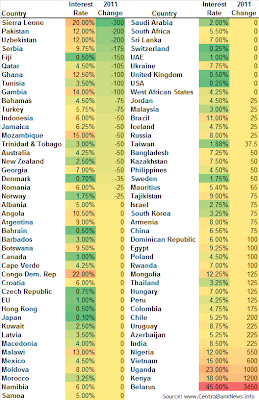London Gold Market Report
from Ben Traynor
BullionVault
Friday 6 January 2012, 09:00 EST
THE DOLLAR cost of buying gold hovered around $1620 an ounce Friday morning London time – becoming a bit more volatile following the release of US employment data but failing to establish a definite direction – while stocks and commodities edged higher.
Silver prices meantime eased around lunchtime, hitting $29.15 per ounce.
On currency markets the Dollar rallied – pushing the Euro down further – after the nonfarm payrolls release showed the US economy added 200,000 private sector non-agricultural jobs in December.
The US unemployment rate fell from 8.7% in November (revised up today from 8.6%) to 8.5%.
From its high above $1.30 on Tuesday, the Euro meantime has since fallen 2.5% against the Dollar.
By Friday lunchtime the price of buying gold in Euros – which touched a 4-week high of €40994 per kilo (€1275 per ounce) looked set for a weekly gain of over 5%.
The Dollar cost of buying gold meantime was headed for a weekly gain of around 3.6%.
“A close above the 200 day moving average at $1632 is needed to shift the market [for buying gold] to Neutral from Bearish,” reckons Russell Browne, technical analyst at bullion bank Scotia Mocatta.
“While gold is pushing towards its 200 day moving average at $1633, we are not convinced that it can sustain a break above this level yet,” adds Standard Bank commodities strategist Walter de Wet.
“Liquidity remains locked up as the European interbank market continues to malfunction…in the physical market, we continue to see steady buying of gold. But this demand is more likely to provide support for gold on dips below $1600 rather than push it substantially higher.”
Friday’s Asian trade saw demand for buying gold in physical form, according to one Shanghai trader.
“Liquidity is back in the market,” said the trader.
“With the Europe outlook still grim, investors would prefer to put their dollars in some safety assets, such as gold.”
In the US, however, the volume of gold to held to back shares in the world’s largest gold ETF, the SPDR Gold Trust (GLD), has not changed since before Christmas.
This contrasts with the world’s biggest silver ETF, the iShares Silver Trust (SLV), where steady outflows since the middle of last month has seen the volume of silver bullion held fall to its lowest level since September 2010.
“We expect silver demand to slow during [2012],” says the latest precious metals note from French bank Natixis, citing “reduced investment demand alongside the current weakness in global industrial demand.”
“There have been good data out of the US,” said Jeremy Friesen, Hon Kong-based commodity strategist at Societe Generale, speaking ahead of today’s nonfarm payrolls release.
“But ultimately the US can’t decouple from the European crisis…there are going to be enough reasons to be worried about global growth and the financial system in the next quarter or two, and gold should benefit from that.”
German factory orders fell 4.8% between October and November last year, Bundesbank figures published this morning show.
Retail sales for the 17-nation Eurozone as a whole meantime fell 2.5% in the year to November – compared to a 0.7% y-o-y drop to October – according to official European Union data, while the European Commission’s economic confidence indicator hit its lowest level in over two years last month.
“This data has recession written all over it,” says Martin van Vliet, Eurozone economist at Dutch bank ING.
A report in French newspaper Les Echos suggests the governments of France, Belgium and Luxembourg are considering fully nationalizing Dexia. The three governments pledged last October to guarantee for a decade €90 billion of the bank’s loans, nationalizing its Belgian division.
In Switzerland meantime Phillip Hildebrand, head of the Swiss National Bank – which last year pegged the Swiss Franc to the Euro – has refused to resign after it emerged that his wife bought US Dollars three weeks before the peg was announced.
Here in the UK – where the Pound this morning hit a 15-month high against the Euro – oil company Shell has announced it will close its final salary pension scheme, the last FTSE 100-listed company to do so.
The Sterling price of buying gold hit £1052 per ounce Friday lunchtime in London – 4.6% up on the start of the week.
Hungary’s leader Viktor Orban has expressed support for central bank governor Andras Simor as the government prepares to renew negotiations with the International Monetary Fund and the European Union over a possible bailout. The IMF and EU last month walked away from negotiations after Orban’s government refused to repeal new legislation seen as threatening the central bank’s independence.
Ben Traynor
BullionVault
Gold value calculator | Buy gold online at live prices
Editor of Gold News, the analysis and investment research site from world-leading gold ownership service BullionVault, Ben Traynor was formerly editor of the Fleet Street Letter, the UK’s longest-running investment letter. A Cambridge economics graduate, he is a professional writer and editor with a specialist interest in monetary economics.
(c) BullionVault 2011
Please Note: This article is to inform your thinking, not lead it. Only you can decide the best place for your money, and any decision you make will put your money at risk. Information or data included here may have already been overtaken by events – and must be verified elsewhere – should you choose to act on it.







